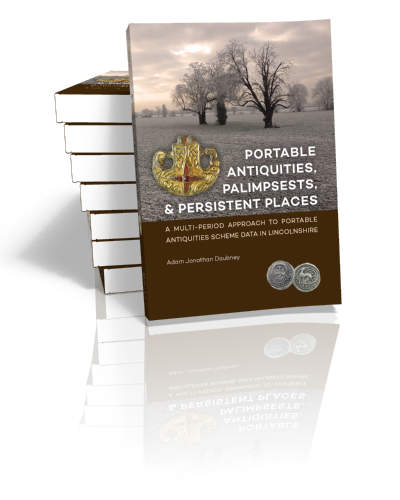Abstract:
Every year thousands of archaeological objects and artefact scatters are discovered by the public, most of them by metal-detector users, but also by people whilst out walking, gardening, or going about their daily work. Once recorded, these finds hold enormous potential in helping us understand the past. In England and Wales these finds are reported to the Portable Antiquities Scheme (PAS), and since 2003 over one million finds have been recorded.
This book explores the significance of PAS data for Lincolnshire, in particular how these finds enhance the ‘known’ archaeological record, and how they come together to form multi-period artefact scatters, defined here for the first time as ‘plough-zone palimpsests’. A bespoke methodology is developed that allows PAS data to be analysed at different scales of time and place. This brings into focus different sources of bias and different interpretative possibilities. A series of case studies then explore these palimpsests on varying scales of time and place. These demonstrate how portable antiquities are important biographical components of ‘temporally-sticky’ or ‘persistent places’, and have the potential to reveal structuring within the landscape over long-periods of time. Combined with other evidence engrained within the landscape, PAS data help to explain how the past influenced the subsequent use of places, and how the aftershocks of human activity resonate in the landscape today.
Contents
Introduction
1. Portable Antiquities, Palimpsests, and Persistent Places
1.1. Introduction
1.2. The Problem of Palimpsests
1.3. Into the Plough-Zone
1.4. From Portable Antiquities to Plough-Zone Palimpsests
1.5. From Palimpsests to Persistent Places
1.6. Conclusions
2. Data and Methodology
2.1. Introduction
2.2. Dividing the Landscape: Historic Landscape Characterisation (HLC)
2.3. HER Data
2.4. PAS Data
2.5. Methodology
2.6. Conclusions
3. Landscape and Bias – The Contribution of PAS data
3.1. Introduction
3.2. HER Data
3.3. The Portable Antiquities Scheme in Lincolnshire
3.4. Spatial Comparison of HER and PAS Data
3.5. Conclusions
4. Across the Borders – The Archaeology of Multi-Period Artefact Scatters
4.1. Introduction
4.2. The Character of Multi-Period PAS Data
4.3. Visualising Persistent Places – HER Data
4.4. The Archaeology of Plough-Zone Palimpsests
4.5. Case Study: Osbournby – A Persistent Place
4.6. Conclusions
5. Barda’s ‘Island’ – The Contribution of Middle Saxon PAS Data to Persistent Places
5.1. Introduction
5.2. Settlement and Economy
5.3. Middle Saxon PAS Data
5.4. Case Study: Barda’s Island
5.5. Conclusions
6. Productive Sites and Persistent Places – The Biography of Two Middle Saxon Assemblages
6.1. Introduction
6.2. ‘Productive’ Sites
6.3. ‘Productive’ Sites in Lincolnshire
6.4. Case Study: Garwick
6.5. Case study: Little Carlton
6.6. Conclusions
7. Conclusions – Portable Antiquities, Palimpsests, and Persistent Places
7.1. Contributions to Portable Antiquities
7.2. Contributions to Palimpsests
7.3. Contributions to Persistent Places
7.4. Reflections and Recommendations


Dr.
Adam Jonathan Daubney
Adam Daubney is the Lincolnshire Finds Liaison Officer for the British Museum’s Portable Antiquities Scheme. He has been recording archaeological objects in Lincolnshire for over fifteen years, and has a particular interest in Roman Britain, and the longer-term use of the rural landscape. Adam has a PhD from the University of Leicester, in which he explored the significance of multi-period artefact scatters in Lincolnshire.
read more









